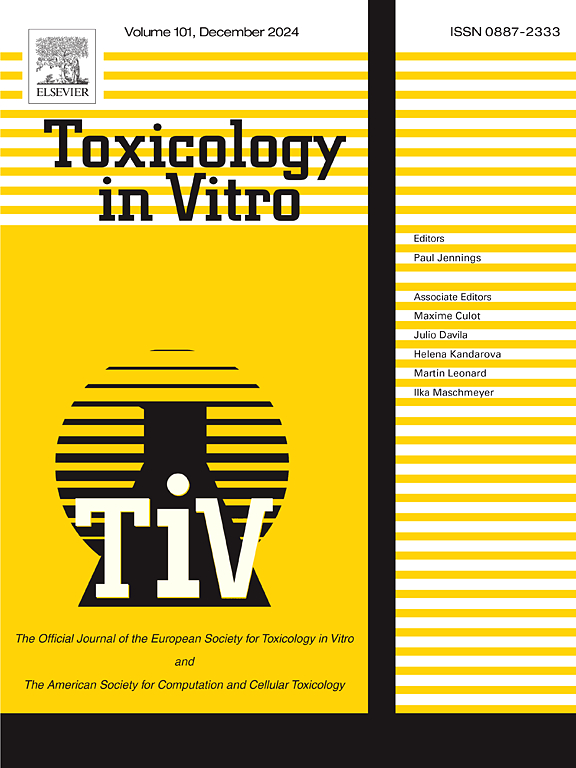A group of novel polyfluoroether substances affects lipid metabolism in human hepatocyte HepaRG cells less than classic perfluoroalkyl compounds
IF 2.6
3区 医学
Q3 TOXICOLOGY
引用次数: 0
Abstract
Per- and polyfluoroalkyl substances (PFAS) are used for numerous industrial applications including the production of fluorosurfactants. Some prominent PFAS, e.g., perfluorooctanoic acid (PFOA) and perfluorooctanesulfonic acid (PFOS), are non-degradable and therefore persist in the environment. They display various toxic properties including dysregulation of hepatic lipid metabolism. At the molecular level, these effects are mainly based on a PFAS-mediated activation of the peroxisome proliferator-activated receptor alpha (PPARα). A group of novel, degradable polyfluoroether compounds has been designed as building blocks for the production of alternative, degradable fluorosurfactants. In the present study, we examined the capacity of four of these novel polyfluoroether compounds to induce PPARα activation, increase intracellular triglyceride accumulation, and produce a cytotoxic response. In contrast to some classic PFAS including PFOA and PFOS, the novel compounds neither activated PPARα in a transactivation assay, nor did they induce expression of selected PPARα-dependent target genes in differentiated HepaRG cells, a model for human hepatocytes. They also did not induce triglyceride accumulation in HepaRG cells. The in vitro data indicate that the polyfluoroether compounds tested in the present study are not PPARα agonists. Since PPARα agonist activity is often associated with toxic responses, it can be assumed that these substances are less toxic than classic PFAS such as PFOA and PFOS, at least with respect to PPARα-dependent toxicity mechanisms.
与传统的全氟烷基化合物相比,一组新型多氟醚物质对人类肝细胞 HepaRG 细胞脂质代谢的影响较小。
全氟和多氟烷基物质(PFAS)用于许多工业应用,包括生产含氟表面活性剂。一些主要的全氟辛烷磺酸,如全氟辛酸和全氟辛烷磺酸,是不可降解的,因此在环境中持续存在。它们表现出各种毒性,包括肝脏脂质代谢失调。在分子水平上,这些作用主要基于pfas介导的过氧化物酶体增殖物激活受体α (PPARα)的激活。一组新的、可降解的聚氟醚化合物被设计为生产可替代的、可降解的氟表面活性剂的基石。在本研究中,我们检测了四种新型多氟醚化合物诱导PPARα活化、增加细胞内甘油三酯积累和产生细胞毒性反应的能力。与一些经典的PFAS(包括PFOA和PFOS)相比,这些新型化合物既没有在反激活实验中激活PPARα,也没有在分化的HepaRG细胞(人类肝细胞模型)中诱导特定的PPARα依赖性靶基因的表达。它们也不会在HepaRG细胞中诱导甘油三酯积累。体外实验数据表明,本研究中测试的多氟醚化合物不是PPARα激动剂。由于PPARα激动剂活性通常与毒性反应相关,因此可以假设这些物质的毒性低于PFOA和PFOS等经典PFAS,至少就PPARα依赖性毒性机制而言。
本文章由计算机程序翻译,如有差异,请以英文原文为准。
求助全文
约1分钟内获得全文
求助全文
来源期刊

Toxicology in Vitro
医学-毒理学
CiteScore
6.50
自引率
3.10%
发文量
181
审稿时长
65 days
期刊介绍:
Toxicology in Vitro publishes original research papers and reviews on the application and use of in vitro systems for assessing or predicting the toxic effects of chemicals and elucidating their mechanisms of action. These in vitro techniques include utilizing cell or tissue cultures, isolated cells, tissue slices, subcellular fractions, transgenic cell cultures, and cells from transgenic organisms, as well as in silico modelling. The Journal will focus on investigations that involve the development and validation of new in vitro methods, e.g. for prediction of toxic effects based on traditional and in silico modelling; on the use of methods in high-throughput toxicology and pharmacology; elucidation of mechanisms of toxic action; the application of genomics, transcriptomics and proteomics in toxicology, as well as on comparative studies that characterise the relationship between in vitro and in vivo findings. The Journal strongly encourages the submission of manuscripts that focus on the development of in vitro methods, their practical applications and regulatory use (e.g. in the areas of food components cosmetics, pharmaceuticals, pesticides, and industrial chemicals). Toxicology in Vitro discourages papers that record reporting on toxicological effects from materials, such as plant extracts or herbal medicines, that have not been chemically characterized.
 求助内容:
求助内容: 应助结果提醒方式:
应助结果提醒方式:


